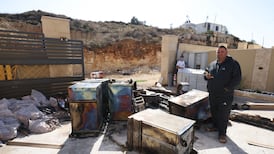The scene unspooled as if in a disaster film: As firefighters fought to control a blaze in one of Tehran’s most prominent high-rise buildings on Thursday, the structure suddenly collapsed in a smoldering heap of wreckage reminiscent of the scene in New York on September 11th, 2001 – all while millions watched on Iranian state television.
The state-run channel PressTV said that at least 20 firefighters were confirmed dead and that dozens of people could be trapped beneath the rubble. But other local news agencies said that as many as 50 firefighters and shopkeepers could have been inside the building when it collapsed.
“It was total chaos, there was dust, there were people everywhere. No one knew what to do,” said Nasim Khakpour, a Tehran resident who had gone out to buy a guitar for her brother in a shop in the neighbourhood. Firefighters had battled the blaze for several hours as police officers tried to shoo away shopkeepers trying to return to collect their valuables, PressTV reported. Then came the collapse. As the building fell, a television journalist doing a stand-up in front of the building suddenly raised his voice. Onlookers could be heard gasping and shrieking. Several firefighters burst into tears.
“They had been trying to put out the fire for hours when suddenly the building just collapsed,” said Ibrahim Najafi, a cosmetics seller, who could see the building crashing down from his shop window. He said there were 590 stores, offices and warehouses in the building. “My friends are in there, what a horrible day.”
People at the scene were visibly upset, and the police were required to control angry crowds who yelled at security forces who they said had arrived too late. “My friend is calling me from under the rubble, help him,” one man was heard shouting.
Chaotic aftermath
In the chaotic aftermath of the collapse, ambulances had to fight their way through onlookers drawn to the scene, some taking selfies in front of the rubble. Army conscripts had to be deployed to clear paths for the emergency vehicles.
The high-rise, the 17-storey Plasco Building in the centre of Tehran, housed a shopping centre and garment manufacturers and was as familiar to most residents as the Empire State Building in New York. Built in 1962 by Habib Elghanian, an Iranian-Jewish businessman, and named for his company, which manufactured plastics, it was the city’s first modern high-rise and long stood as a symbol of the modernisation drive during the reign of Shah Mohammed Reza Pahlavi. After the 1979 revolution, Elghanian was accused of spying for Israel and executed.
Firefighters said the blaze appeared to have started in the morning on the 11th floor before spreading to a floor below, trapping some of their colleagues inside. Firefighters on the ground stared upward as the fire advanced, apparently horrified by the predicament faced by those in the building. Two of them comforted a colleague, his face ashen, as he knelt, pointing at the building.
Cinematic choreography
The choreography of the structure’s collapse played out with cinematic inevitability. First, one side of the building crashed, just missing a firefighter standing on a ladder, the Associated Press reported. Then, the rest came tumbling down.
So dense were the plumes of smoke that Jalal Maleki, a spokesman for Tehran’s fire brigade, told the AP the cloud was “visible from the southern parts of Tehran”, miles away.
Masoumeh Abad, a member of the Tehran City Council, said tenants of the building had been warned “at least 20 times” that maintenance was needed, the semiofficial news agency Fars reported. But other local news outlets suggested that the municipality had been lax in implementing safety regulations.
The Plasco Building had been fully stocked with garments for the Iranian New Year on March 21st, for which Iranians traditionally shop for new clothes, and there were reports that the clothing had choked passage through the hallways, impeding the firefighters. – (New York Times service)









